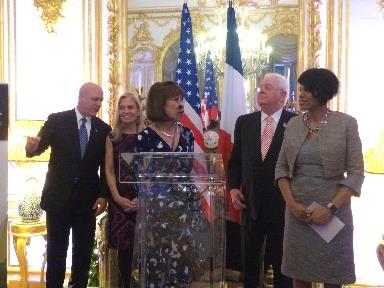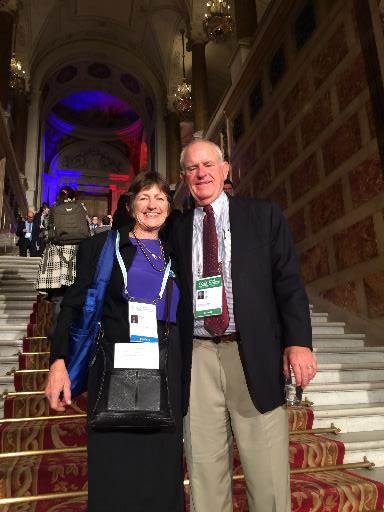| |
Paris, Sunday, December 6, 2015 – This is the first day in a week without scheduled events and an opportunity to catch up on my reports.
Two days ago (Saturday) we started with a presentation at the conference center at Le Bourget, “Community Choice Energy – Power to the People,” about Community Choice Aggregation, Marin Clean Energy and the City of Richmond’s experiences with renewable energy. Presenting were Shawn Marshall of LEAN Energy, Dawn Weisz of Marin Clean Energy (MCE), Cliff Rechtshaffen, Senior Advisor on Energy to California Governor Jerry Brown.
The session was covered by International Institute for Sustainable Development Reporting Services:
Community Choice Energy: Power to the People! Presented by: Sequoia Foundation
This event, moderated by Tom Kelly, Director, Sequoia Foundation, focused on the role of community choice energy (CCE) in accelerating the transition to a low-carbon economy, hearing examples from throughout California, US.
Shawn Marshall, Lean Energy US, presented on the CCE model and provided an overview of national-, state- and municipal-level legislation relating to community energy. She emphasized that CCE does not require federal legislation, and in fact that the majority of progress in community choice energy in the US is occurring at the state level. She underscored successful community energy projects around the US, noting that programmes with broader social benefits tend to be more successful at retaining customers in the long term.
Cliff Rechtschaffen, Office of California Governor Jerry Brown, presented on how community energy can accelerate and catalyze the transition to a low carbon economy. He contextualized progress by highlighting multisector, state-level climate goals addressing cap-and-trade, transport, forestry, Short-Lived Climate Pollutants (SLCPs), buildings, soils and decarbonizing the electric system. He noted former Governor Arnold Schwarzenegger's Executive Order to reduce greenhouse gas emissions by 80% of 1990 levels by 2050, which is spurring the creation of the most clean energy jobs in any state in the US.
Dawn Weisz, CEO, Marin Clean Energy (MCE), explained MCE was the first clean energy CCE in Western US. She explained its structure is a public-private hybrid model, being a public agency but using private renewable energy infrastructure. Underscoring that the model does not add to the state’s tax burden, she said “the programme is just redirecting a revenue stream that already exists”, and has succeeded in eliminating 63,500 MT of CO2 between 2010-2013. Weisz highlighted MCE now has more than 170,000 customers, but that they also work with local citizens on energy efficiency, saying “the cleanest energy is the energy we don’t use, of course.”
Tom Butt, Mayor, City of Richmond, California, talked about the energy transition in the city, highlighting a shift from 27% to 56% renewables which has saved rate-payers over US$1 million. On challenges to further improvement, he suggested “people just don’t like change”, but noted the city’s plans to build a 10.5 MW solar farm.
In the ensuing discussion, participants discussed, inter alia: the challenges of addressing “higher hanging fruit” once energy transition is further under way; collaboration among similar CCE programmes in different municipalities; rural community cooperative models; and how to achieve meaningful civic engagement.

Dawn Weisz, CEO, MCE, presented on California’s first community choice energy programme, which now has more than 170,000 customers.

Cliff Rechtschaffen, Office of California Governor Jerry Brown, said California has arguably the most progressive greenhouse gas emission policies in the world

Shawn Marshall, Lean Energy US, said state-level regulations are taking the lead in renewable energy standards and robust cap-and-trade systems throughout the US

A participant from Minnesota asks panelists how community ownership models such as energy cooperatives fit into the CCE model.

Panel (L-R): Shawn Marshall, Lean Energy US; Cliff Rechtschaffen, Office of California Governor Jerry Brown; Dawn Weisz, MCE; and Tom Butt, Mayor, City of Richmond, California.

Community Choice Energy – Power to the People, Tom Butt presenting about CCA and MCE in Richmond
From Le Bourget, we hurried back to the hotel to change clothes and get ready for afternoon and evening events. After a 45-minute walk down Boulevard St. Germaine and across the Seine to Place de la Concorde, we reached the residence of the U.S. ambassador to France, Jane Bentley. About three dozen mayors and others assembled in a conference room for a briefing by Deputy Special Envoy for Climate Change Karen Florini and Deputy Assistant Secretary for Public Affairs David Duckenfield.
The message I heard was that while the body of a draft agreement had been negotiated, it had a lot of blanks in it yet to be filled out. Those missing pieces to be worked on next week include all the important issues like the target temperature rise limit and the exact long term goals for each country. Florina predicted that the end result would be non-binding but would remain flexible to take advantage of changes in emissions from individual countries and new technology. She emphasized that the final product would include transparency and accountability and would be reviewed every five years. It will not include compensation and liability for lesser emitting and poorer countries. I’m not sure whether this is good, as seemed to be the spin, or is sugar coating a less than successful culmination. In any event, the work will not be done until next Friday.
After the briefing, we moved downstairs and joined with even more people for a reception with remarks from Ambassador Bentley and U.S. Conference of Mayors President Stephanie Rawlings-Blake (mayor of Baltimore), who reminded us that the U.S. Conference of Mayors had adopted an aggressive position on climate change in 2005 and has just published “U.S. mayors Report on a Decade of Global Climate Leadership.” Others speaking included Tom Cochran, CEO and executive director and Mitch Landrieu, mayor of New Orleans and second vice-president.

Mitch Landrieu, Jane Bentley, Elizabeth Kautz (former U.S. Conference of mayors president), Tom Cochran and Stephanie Rawlings-Blake

Shirley with Oakland mayor Libby Shaaf

Shirley with Santa Monica Mayor Pam O’Conner, who serves with me on the board of the Local Government Commission
From the Embassy, we moved on via the Metro and on foot to the Eiffel Tower where Paris Mayor Anne Hidalgo was hosting a reception on the first upper level.

Eiffel Tower at night

Tom Butt with Paris Mayor Anne Hidalgo at the Eiffel Tower

Reception at the Eiffel Tower

Shirley and four mayors from Cameroon
The day before, Friday’s Climate Summit for Local Leaders at Paris City Hall was an all-day extravaganza, a combination political rally and old-fashioned tent revival focused on climate change.
The underlying theme was that cities are more nimble and less constrained by politics than national governments. Cities can therefore act faster and be more creative, and many are already proving that by taking the lead in climate change mitigation. The list of presenters included mayors of the world’s great cities interspersed with personalities including Leonardo DiCaprio, Robert Redford and Al Gore.
Below is a summary from ICLEI:
On 4 December 2015, hundreds of mayors convened at Paris City Hall for the Climate Summit for Local Leaders, as part of the largest global convening of mayors, governors and local leaders focused on climate change.
The afternoon general session began with opening remarks from cohosts Anne Hidalgo, Mayor of Paris, and Michael Bloomberg, UN Secretary-General’s Special Envoy for Cities and Climate Change, who emphasized the strong base of knowledge that exists among cities across the world. Mayor Hidalgo noted that cities represent fifty percent of the solution for climate change and must share ideas and practices to ensure that cities create better environments for their citizens.
Hoesung Lee, Chair of the IPCC followed these remarks by emphasizing the need to focus on climate change solutions rather than problems. The science clearly shows that we face dire consequences without action, which means the world must now use innovative and disruptive technologies that give way to a new economy and job creation.
Leonardo DiCaprio echoed Hidalgo in emphasizing the role of knowledge and exchange and collaboration, stating that “one thing is fundamentally clear: we need to find the will to work together,” noting the importance of strong networks like the Compact of Mayors, which recently reached 400 committed cities across the world. DiCaprio also called for greater ambitious and quick action by local and regional leaders, toward goals such as 100 percent renewable energy, which are possible even if they appear out of reach.
Following remarks by a number of officials, a panel consisting of the Mayors of New Orleans (US), Barcelona (Spain) and Amman (Jordan) joined a first nations representative in discussing how to deal with climate change risks, agreeing that cities and people must adapt and respond to signals coming from the natural environment. New Orleans, a city surrounded by water, has decided to work with its water resources, rather than against them, while the May or Barcelona, Ada Colau, recognizes that “if we do not want climate change, then we have to change ourselves.”
Park Wonsoon, Mayor of Seoul, South Korea and President of ICLEI – Local Governments for Sustainability spoke to the role of local and regional government networks in advancing sustainability goals, explaining that the more than 1,000 ICLEI members agreed to implement the Seoul Action Plan, which includes specific measures for sustainable growth. He called for participants to “bear in mind the saying, ‘think globally, act locally,” a theme that resonates powerfully at an event that highlighted the power and potential of local climate ambitions amidst the ongoing international negotiations in Paris.
For more information on the agenda and speakers, visit http://climatesummitlocalleaders.paris/.
Opening remarks were by Anne Hidalgo, Mayor of Paris, Michael Bloomberg, UN Secretary Generals’ Special Envoy for Cities and Climate Change, Kadir Topbas, Mayor of Istanbul and President of UCLG, Eduardo Paes, Mayor of Rio de Janeiro and chair of C40, Park Won-soon, Mayer of Seoul and President of ICLEI, and Khalifa Sall, Mayor of Dakar and Secretary General of AIMF.


Paris City Hall (Hotel de Ville) is like a palace. It was started in 1357, expanded in 1533 and restored in 1892

Paris Mayor Anne Hidalgo
After a press conference by ICLEI at City Hall, we had lunch at a restored market hall that reminded me of the Craneway.

Lunch at Carreau de Temple, Shirley and I are sitting between Akel Biltaji, mayor of Amman, Jordan (oldest city in the world at 12,000 yerars, he says), and Robin Chase, founder of Zipcar

Group photo of mayors after lunch

DiCaprio: “To all the mayors and governors in this room: commit to moving to no less than 100% renewable energy as soon as possible. Do not wait another day.”

Robert Redford invited U.S. mayors to Sundance ten years ago to talk about climate change. He was disappointed that not much cam of it but believes the issue is now beginning to move. E said mayors are “close to the ground” and are in the best position to move quickly.

Al Gore: I am filled with hope and optimism. We will win this struggle.” Just after this photo was taken and the interview was ongoing, the interviewer fainted, but apparently is okay

Tom Butt signing the Compact of Mayors Commitment
Final take away: Mayors here in Paris are serious about climate change and aim to lead the charge. An underlying theme to all of this is that the effort has to be equitable and include environmental and social justice. |
|

